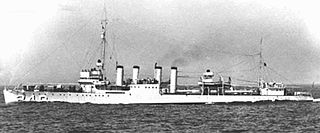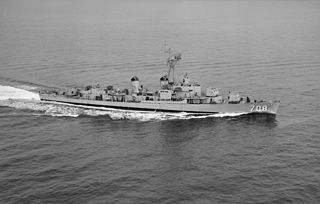
USS Newman K. Perry (DD-883/DDR-883), was a Gearing-class destroyer of the United States Navy.

USS Dickerson (DD-157) was a Wickes-class destroyer in the United States Navy, and was converted to a high-speed transport at Charleston, South Carolina and designated APD-21 in 1943. She was named for Mahlon Dickerson (1770–1853), Secretary of the Navy from 1834 to 1838.

USS Hawkins (DD-873) was a Gearing-class destroyer in the United States Navy during World War II. Following the war, the ship saw service in the Korean War and in the 1970s, was transferred to the Republic of China Navy as Tze Yang. She remained in service until the 1990s. The ship was then scrapped with the exception of her superstructure, which became part of a display and training ground at the Zuoying Naval Academy.

The third USS Dale (DD-290) was a Clemson-class destroyer in the United States Navy. She was named for Richard Dale.

USS Joseph P. Kennedy Jr. (DD-850) is a former United States Navy Gearing-class destroyer. The ship was named after Lieutenant Joseph P. Kennedy Jr., a naval aviator, son of the former Ambassador to Britain, Joseph P. Kennedy Sr., and older brother of future President John F. Kennedy. Joseph P. Kennedy Jr. served, with interruptions for modernization, until 1973. Among the highlights of her service are the blockade of Cuba during the Cuban Missile Crisis and the afloat recovery teams for Gemini 6 and Gemini 7. Joseph P. Kennedy Jr. is on display as a museum ship in Battleship Cove, Fall River, Massachusetts. She was added to the National Register of Historic Places in 1976, and designated a National Historic Landmark in 1989 as one of a small number of surviving Gearing-class destroyers.

The first USS Philip (DD–76) was a Wickes-class destroyer in the United States Navy during World War I, later transferred to the Royal Navy as HMS Lancaster. She was named for John Woodward Philip.

USS Du Pont (DD–152) was a Wickes-class destroyer in the United States Navy during World War II, later reclassified as AG-80. She was the second ship named for Rear Admiral Samuel Francis Du Pont.
USS Dallas (DD-199) was a Clemson-class destroyer in the United States Navy during World War II. She was the second ship named for Captain Alexander J. Dallas, and was later renamed Alexander Dallas.

USS Sturtevant (DD-240) was a Clemson-class destroyer in the United States Navy during World War II. She was the first ship named for Albert D. Sturtevant.

The third USS Bainbridge (DD-246) was a Clemson-class destroyer in the United States Navy during World War II. She was named for Commodore William Bainbridge, who served in the War of 1812 and the First and Second Barbary Wars.

The fourth USS Lawrence (DD-250) was a Clemson-class destroyer in the United States Navy during World War II. She was named for James Lawrence.

USS Sharkey (DD-281) was a Clemson-class destroyer in the United States Navy following World War I. She was named for William J. Sharkey.

USS Breck (DD-283) was a Clemson-class destroyer in the United States Navy following World War I. She was named for Joseph Berry Breck.

USS Isherwood (DD-284) was a Clemson-class destroyer in service with the United States Navy from 1919 to 1930. She was scrapped in 1931.

The first USS Lardner (DD-286) was a Clemson-class destroyer in service with the United States Navy from 1919 to 1930. She was scrapped in 1931.

USS Putnam (DD-287) was a Clemson-class destroyer in the United States Navy following World War I. She was named for Charles Putnam.

The first USS Farenholt (DD-332) was a Clemson-class destroyer in the United States Navy following World War I. She was named for Oscar Farenholt.

USS Harlan R. Dickson (DD-708), an Allen M. Sumner-class destroyer, was named for Lieutenant Commander Harlan Rockey Dickson.

USS Norris (DD-859) was one of 98 Gearing-class destroyers in the United States Navy during the end of World War II. Norris was active from 9 June 1945 to 4 December 1970. Although built too late to see action during the war, the ship served in the Pacific, Atlantic, Asiatic, and Mediterranean areas.

USS Huse (DE-145) was a U.S. Navy destroyer escort launched by Consolidated Steel Corp., Orange, Texas on 23 March 1943, during World War II. The ship was sponsored by Mrs. L. M. Humrichouse, daughter of Admiral Harry McLaren Pinckney Huse, whom the ship was named after and commissioned on 30 August 1943.



















